Related Research Articles

A caravanserai was a roadside inn where travelers (caravaners) could rest and recover from the day's journey. Caravanserais supported the flow of commerce, information and people across the network of trade routes covering Asia, North Africa and Southeast Europe, most notably the Silk Road. Often located along rural roads in the countryside, urban versions of caravanserais were also historically common in cities throughout the Islamic world, and were often called other names such as khan, wikala, or funduq.

Mughal architecture is the type of Indo-Islamic architecture developed by the Mughals in the 16th, 17th and 18th centuries throughout the ever-changing extent of their empire in the Indian subcontinent. It developed from the architectural styles of earlier Muslim dynasties in India and from Iranian and Central Asian architectural traditions, particularly Timurid architecture. It also further incorporated and syncretized influences from wider Indian architecture, especially during the reign of Akbar. Mughal buildings have a uniform pattern of structure and character, including large bulbous domes, slender minarets at the corners, massive halls, large vaulted gateways, and delicate ornamentation; examples of the style can be found in modern-day Afghanistan, Bangladesh, India and Pakistan.

The Bayezid II Mosque is an early 16th-century Ottoman imperial mosque located in Beyazıt Square in Istanbul, Turkey, near the ruins of the Forum of Theodosius of ancient Constantinople.

El Badi Palace or Badi' Palace is a ruined palace located in Marrakesh, Morocco. It was commissioned by the sultan Ahmad al-Mansur of the Saadian dynasty a few months after his accession in 1578, with construction and embellishment continuing throughout most of his reign. The palace, decorated with materials imported from numerous countries ranging from Italy to Mali, was used for receptions and designed to showcase the Sultan's wealth and power. It was one part of a larger Saadian palace complex occupying the Kasbah district of Marrakesh.

The large Fatih Mosque is an Ottoman mosque off Fevzi Paşa Caddesi in the Fatih district of Istanbul, Turkey. The original mosque was constructed between 1463 and 1470 on the site of the Church of the Holy Apostles. Seriously damaged in the 1766 earthquake, it was rebuilt in 1771 to a different design. It is named after the Ottoman sultan Mehmed the Conqueror, known in Turkish as Fatih Sultan Mehmed, who conquered Constantinople in 1453.
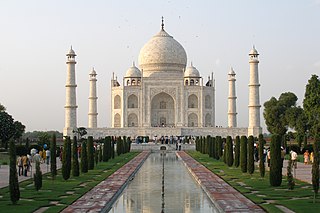
The Taj Mahal represents the finest and most sophisticated example of Indo-Islamic architecture. Its origins lie in the moving circumstances of its commission and the culture and history of an Islamic Mughal empire's rule of large parts of India. The distraught Mughal Emperor Shah Jahan commissioned the project upon the death of one of his favorite wives Mumtaz Mahal.
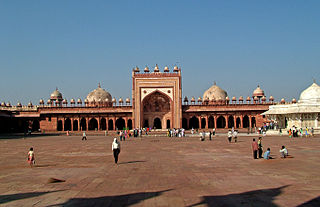
The Jama Masjid is a 16th-century congregational mosque in the UNESCO World Heritage Site of Fatehpur Sikri, located in Uttar Pradesh, India. It was built by Mughal emperor Akbar, and was the largest mosque in the empire at the time of construction. The Jama Masjid's design drew from earlier mosques built by various pre-Mughal sultanates, and served as an important precedent in subsequent Mughal architecture.

The Calumet and Hecla Industrial District is a historic district located in Calumet, Michigan and roughly bounded by Hecla & Torch Lake Railroad tracks, Calumet Avenue, Mine and Depot Streets. The district contains structures associated with the copper mines worked by the Calumet and Hecla Mining Company, located along a line above the copper lode, where railroad tracks connected separate mine heads. The Historic District is completely contained in the Calumet Historic District and the Keweenaw National Historical Park. It was designated a Michigan State Historic Site in 1973 and was listed on the National Register of Historic Places in 1974.
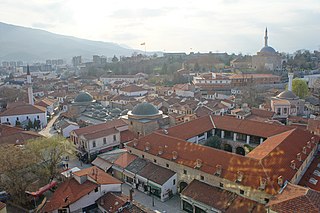
The Old Bazaar also known as Turkish Bazaar is a bazaar located in Skopje, North Macedonia, situated on the eastern bank of the Vardar River, stretching from the Stone Bridge to the Bit-Pazar and from the Skopje Fortress to the Serava river. The Old Bazaar falls primarily within the borders of Čair Municipality but a part of it is located in Centar Municipality. As one of the oldest and largest marketplaces in the Balkans, it has been Skopje's centre for trade and commerce since at least the 12th century.

The Ganjali Khan Complex is a Safavid-era building complex, located in the old center of city of Kerman, Iran. The complex is composed of a school, a square, a caravanserai, a bathhouse (hammam), an Ab Anbar, a mint, a mosque and a bazaar.

Seljuk architecture comprises the building traditions that developed under the Seljuk dynasty, when it ruled most of the Middle East and Anatolia during the 11th to 13th centuries. The Great Seljuk Empire contributed significantly to the architecture of Iran and surrounding regions, introducing innovations such as the symmetrical four-iwan layout and the first widespread creation of state-sponsored madrasas. Their buildings were generally constructed in brick, with decoration created using brickwork, tiles, and carved stucco.

The Katra Masjid is a former caravanserai, mosque and the tomb of Nawab Murshid Quli Khan. It was built between 1723 and 1724. It is one of the largest caravanserais in the Indian subcontinent. It was built during the 18th century, when the early modern Bengal Subah was a major hub of trade in Eurasia. The Katra Masjid is located in the north eastern side of the city of Murshidabad, in the Indian state of West Bengal. The most striking feature of the structure are the two large corner towers having loopholes for musketry.

The Badshahi Mosque is an iconic Mughal-era congregational mosque in Lahore, Punjab, Pakistan. The mosque is located opposite of Lahore Fort in the outskirts of the Walled City and is widely considered to be one of Lahore's most iconic landmarks.

The Akbari Sarai is a large caravan inn ("sarai"), located in Shahdara Bagh in Lahore, Punjab, Pakistan. Dating from 1637, the sarai was originally built for travelers, as well as for caretakers of the Tomb of Jahangir. The sarai is most notable for being the best-preserved example in Pakistan, as well as for its large gateway that is richly embellished with pietra dura that serves as a portal to the tomb of Jahangir.

Deir-e Gachin Caravansarai is a historic caravansarai in Iran, located in the center of Kavir National Park. Because of its history and unique qualities, it is sometimes called the "Mother of Iranian Caravansarais". It is located in the Central District of Qom County, 80 kilometers north-east of Qom and 35 kilometers south-west of Varamin. This monument was registered in Iran's National Heritage List on September 23, 2003. The caravanserai was originally built in the Sasanian era and underwent restorations and reconstructions in the Seljuk, Safavid and Qajar eras. Its current form belongs to Safavid era. This caravanserai is situated on the ancient rout from Ray to Isfahan.
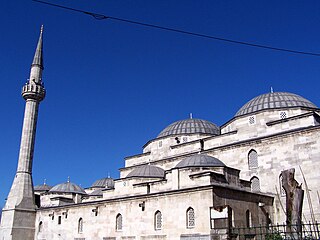
The Mahmut Pasha Mosque is a 15th-century Ottoman mosque near the Grand Bazaar in the Fatih district of Istanbul, Turkey.

The Kürkçü Han is a large historic han (caravanserai) in Istanbul, Turkey. Founded by Mahmud Pasha, the grand vizier of Mehmet II, it was completed in 1467 and is the oldest surviving caravanserai in the city, although it has been modified, partly ruined, and renovated over the centuries.
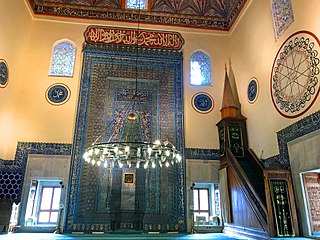
Early Ottoman architecture corresponds to the period of Ottoman architecture roughly up to the 15th century. This article covers the history of Ottoman architecture up to the end of Bayezid II's reign, prior to the advent of what is generally considered "classical" Ottoman architecture in the 16th century. Early Ottoman architecture was a continuation of earlier Seljuk and Beylik architecture while also incorporating local Byzantine influences. The new styles took shape in the capital cities of Bursa and Edirne as well as in other important early Ottoman cities such as Iznik. Three main types of structures predominated in this early period: single-domed mosques, "T-plan" buildings, and multi-domed buildings. Religious buildings were often part of larger charitable complexes (külliyes) that included other structures such as madrasas, hammams, tombs, and commercial establishments.
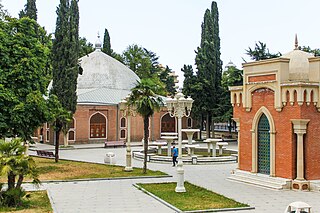
Shah Abbas Square is a square located in the historical center of the city of Ganja, Azerbaijan. At one time, it was the main memorial complex of the suburb of the Ganja fortress. The complex of Shah Abbas Square was firstly mentioned in the plan of the Ganja fortress of 1797. This architectural ensemble, located in the center of the suburb, consisted of a mosque, a bathhouse and other buildings.

The Polvon Gate is the eastern gate of the Itchan Kala fortress in Khiva (1806). The people also call it Poshshob (Jallod) Gate or Slave Gate. This gate is the main entrance to Khiva, Uzbekistan, and it was built by seven craftsmen under the supervision of a master builder. A canal that brought water from the Amu Darya river surrounded the fortress wall. The gate had a bridge that could be lifted at night. Polvon Gate's master builder received the same salary as the master builder who worked at the Ark Gate, the gate of the Khiva Khan's palace. The current appearance of Polvon Gate is the result of several renovations. Previously, the gate protruded slightly outward from the fortress wall. It had a watchtower on top that allowed to observe the outside of the city. The gate was rebuilt in 1806 by Eltuzarkhan from baked bricks. In addition, a long corridor – a vault was also built, which served as a place for trade stalls. The towers on the side of the gate were connected to the city wall. After the construction of the caravanserai and the covered bazaar in 1832–1833, the gate lost its role as a market. In 1835, the Olloqulixon Madrasa was built inside the gate, and its western part was rebuilt. A new bathhouse with two domes and a portal was built in front of it. The inner courtyard was enlarged as a result of the construction of the Olloqulikhan madrasah. It was also called the “Flower Gate” because of its beautiful glazed tiles. The gate was named after the Khiva poet, who lived in the seventh century, the author of more than three hundred quatrains, and the defender of the city, Pahlavon Mahmud. Pahlavon Mahmud was buried in a beloved tomb behind the Juma Mosque.
References
- 1 2 3 4 5 6 7 8 9 10 11 12 13 14 15 16 17 Yasin, Aamir (March 18, 2018). "Sarai Kharbuza served both commoners and kings". DAWN.COM.
- ↑ "سرائے خربوزہ - ایکسپریس اردو".
- ↑ "اسلام آباد کی واحد سرائے کس حال میں ہے؟". Independent Urdu . August 27, 2022.
- ↑ "Sarai Kharbooza fading into oblivion". The Express Tribune. October 24, 2021.